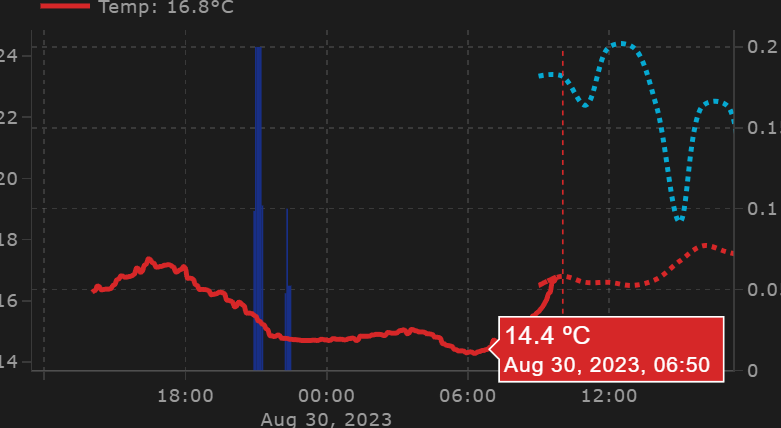In case anyone is interested in getting something useful out of this Plotly chart, I am now starting to see the light in the tunnel.
The code is more than 300 lines long, that’s the thing about Plotly, you get excited and it grows, but it’s really cool!
type: custom:plotly-graph
title: null
time_offset: 3h
autorange_after_scroll: true
config:
displaylogo: false
scrollZoom: true
displayModeBar: true
entities:
- entity: sensor.temperatura_tado
mode: lines+markers+text
textposition: top right
textfont:
color: rgba ( 0, 221, 51 , 1)
size: 10
marker:
size: 8
color: rgba( 0, 221, 51 , 1)
showlegend: true
hovertemplate: >-
<span style="text-align: center; font-size: 20px;">%{y:.1f}
ºC</span><br>%{x}<extra></extra>
texttemplate: ' %{y:.0f}'
yaxis: y1
name: TC
line:
width: 2
color: rgba ( 0, 221, 51 , 1)
- entity: sensor.aire_acondicionado_ac
legendgroup: 2
showlegend: true
visible: true
name: P
mode: lines+markers
fill: tozeroy
fillcolor: rgba( 225, 255, 0 ,.1)
marker:
size: 3
color: rgba( 225, 255, 0 , 1)
yaxis: y4
line:
width: 2
color: rgba ( 225, 255, 0 , 0.1)
- entity: sensor.netatmo_casa_de_sh_interior_exterior_temperature
showlegend: true
visible: legendonly
mode: lines
hovertemplate: >-
<span style="text-align: center; font-size: 20px;">%{y:.1f}
ºC</span><br>%{x}<extra></extra>
texttemplate: ' %{y:.1f}'
yaxis: y1
marker:
size: 20
color: rgba(165,165,0,0.9)
name: 'N'
line:
shape: spline
width: 3
color: ' #ffab3b '
- entity: sensor.switchbot_meter_bt_temperatura
showlegend: true
hovertemplate: >-
<span style="text-align: center; font-size: 20px;">%{y:.1f}
ºC</span><br>%{x}<extra></extra>
yaxis: y1
textposition: bottom left
texttemplate: ' %{y:.1f}'
name: SB
line:
width: 3
shape: spline
color: rgba ( 249, 37, 8, 0.8)
- entity: sensor.netatmo_casa_de_sh_interior_temperature
showlegend: true
visible: legendonly
hovertemplate: >-
<span style="text-align: center; font-size: 20px;">%{y:.1f}
ºC</span><br>%{x}<extra></extra>
yaxis: y1
name: 'N'
texttemplate: ' %{y:.1f}'
line:
shape: spline
width: 3
color: rgba ( 0, 201, 255 , 0.9)
- entity: sensor.aire_acondicionado_temperature
showlegend: true
hovertemplate: >-
<span style="text-align: center; font-size: 20px;">%{y:.1f}
ºC</span><br>%{x}<extra></extra>
yaxis: y1
name: T
texttemplate: ' %{y:.1f}'
line:
shape: spline
width: 3
color: rgba ( 0, 111, 255 , 0.9)
- entity: ''
hovertemplate: '<span style="display: none;"> <extra></extra> '
name: Now
yaxis: y9
texttemplate: ' Now'
showlegend: false
show_value: true
line:
width: 2
color: rgba ( 255,255,255 , 1 )
x: $ex [Date.now(), Date.now()]
'y':
- 0
- 1
defaults:
entity:
show_value: false
yaxes:
fixedrange: true
rangemode: tozero
fn: |
$fn({getFromConfig, vars})=> {
const range = getFromConfig("visible_range");
const width = range[1] - range[0];
vars.scroll = (label, p) => ({
args: [
{
layout: {
"xaxis.range": [range[0] + width*p, range[1] + width*p],
}
}, {
transition: {
duration: 150,
}
}
],
label,
method: "animate",
})
vars.zoom = (label, h) => ({
args: [
{
layout: {
"xaxis.range": [Date.now()-1000*60*60*h, Date.now()],
}
}
],
label,
method: "animate",
})
}
layout:
modebar:
orientation: v
marker:
size: 20
xaxis:
tickangle: 0
minor:
nticks: 3
tickmode: auto
showgrid: false
tickformat: auto
gridcolor: ' #454545 '
yaxis:
side: left
ticksuffix: null
showticklabels: true
tickangle: 0
minor:
nticks: 4
tickmode: auto
showgrid: true
gridcolor: ' #454545 '
tickformat: auto
range:
- 15
- 35
annotations:
- text: |-
$fn ({hass}) =>
"<span style='font-size: 18px;'><span style='font-weight: bold; color: rgba( 0, 221, 51 , 1)'>"
+ hass.states['sensor.temperatura_tado'].state + "</span></span>º<br>"
+ "</span><span style='font-weight: bold; font-size: 16px;color: rgba( 0, 221, 51 , 1)'>Tado</span><br>"
+ (hass.states['sensor.aire_acondicionado_temperature'] ? "<br><span style='font-size: 30px;color: rgba( 47, 255, 241 , 1)'>❄</span>":'')
xref: x domain
yref: y1 domain
xanchor: center
yanchor: top
x: 1.08
'y': 0.9
showarrow: false
- text: |-
$fn ({hass}) =>
"<span style='font-size: 18px;'><span style='font-weight: bold; color: rgba( 255, 187, 47 , 1)'>"
+ hass.states['sensor.netatmo_casa_de_sh_interior_exterior_temperature'].state + "</span></span>º<br>"
+ "</span><span style='font-weight: bold; color: rgba( 255, 187, 47 , 1)'>NET🌡</span><br>"
+ (hass.states['sensor.aire_acondicionado_temperature'] ? "<br><span style='font-size: 30px;color: rgba( 0, 221, 51 , 1)'></span>":'')
xref: x domain
yref: y1 domain
xanchor: center
yanchor: top
x: 1.08
'y': 0.6
showarrow: false
- text: |-
$fn ({hass}) =>
"<span style='font-size: 18px;'><span style='font-weight: bold; color: rgba( 249, 37, 8 , 1)'>"
+ hass.states['sensor.switchbot_meter_bt_temperatura'].state + "</span></span>º<br>"
+ "</span><span style='font-weight: bold; color: rgba( 249, 37, 8 , 1)'>SB🌡</span><br>"
+ (hass.states['sensor.aire_acondicionado_temperature'] ? "<br><span style='font-size: 30px;color: rgba( 0, 221, 51 , 1)'></span>":'')
xref: x domain
yref: y1 domain
xanchor: center
yanchor: top
x: 1.08
'y': 0.45
showarrow: false
- text: |-
$fn ({hass}) =>
"<span style='font-size: 18px;'><span style='font-weight: bold; color: rgba( 0, 201, 255 , 1)'>"
+ hass.states['sensor.netatmo_casa_de_sh_interior_temperature'].state + "</span></span>º<br>"
+ "</span><span style='font-weight: bold; color: rgba( 0, 201, 255 , 1)'>NET🌡</span><br>"
+ (hass.states['sensor.aire_acondicionado_temperature'] ? "<br><span style='font-size: 30px;color: rgba( 0, 221, 51 , 1)'></span>":'')
xref: x domain
yref: y1 domain
xanchor: center
yanchor: top
x: 1.08
'y': 0.3
showarrow: false
- text: |-
$fn ({hass}) =>
"<span style='font-size: 18px;'><span style='font-weight: bold; color: rgba( 0, 111, 255 , 1)'>"
+ hass.states['sensor.tado_temperature_1_decimal'].state + "</span></span>º<br>"
+ "</span><span style='font-weight: bold; color: rgba( 0, 111, 255 , 1)'>Tado🌡</span><br>"
+ (hass.states['sensor.aire_acondicionado_temperature'] ? "<br><span style='font-size: 30px;color: rgba( 0, 221, 51 , 1)'></span>":'')
xref: x domain
yref: y1 domain
xanchor: center
yanchor: top
x: 1.08
'y': 0.15
showarrow: false
yaxis2:
side: left
showticklabels: false
title: ''
tickangle: 0
minor:
nticks: 3
tickmode: auto
showgrid: true
gridcolor: ' #454545 '
tickformat: auto
yaxis3:
side: left
showticklabels: false
tickangle: 0
minor:
nticks: 3
tickmode: auto
showgrid: true
gridcolor: ' #454545 '
tickformat: auto
yaxis4:
side: left
showticklabels: false
tickangle: 0
minor:
nticks: 3
tickmode: auto
showgrid: true
gridcolor: ' #454545 '
tickformat: auto
yaxis5:
side: left
showticklabels: false
tickangle: 0
minor:
nticks: 3
tickmode: auto
showgrid: true
gridcolor: ' #454545 '
tickformat: auto
height: 500
margin:
l: 40
r: 60
t: 100
updatemenus:
- buttons:
- $fn({vars}) => vars.scroll( '<', -.5)
- $fn({vars}) => vars.scroll( '>', .5)
direction: right
active: -1
pad:
r: 10
t: -90
type: buttons
x: 1
xanchor: right
'y': 1
yanchor: top
- buttons:
- $fn({vars}) => vars.zoom( '2w', 24*14)
- $fn({vars}) => vars.zoom( '2d', 24*2)
- $fn({vars}) => vars.zoom( '12h', 12)
- $fn({vars}) => vars.zoom( '3h', 3)
- $fn({vars}) => vars.zoom( '1h', 1)
direction: right
active: -1
pad:
l: -15
t: -90
type: buttons
x: 0
xanchor: left
'y': 1
yanchor: top
font:
family: Roboto,Noto,sans-serif
size: 14
color: $fn ({css_vars}) => css_vars['primary-text-color']
paper_bgcolor: rgba(0, 0, 0, 0.4)
plot_bgcolor: rgba(0, 0, 0, 0)
legend:
itemwidth: 1
hours_to_show: 30








